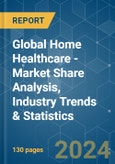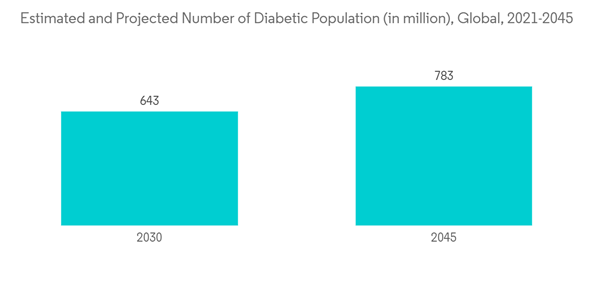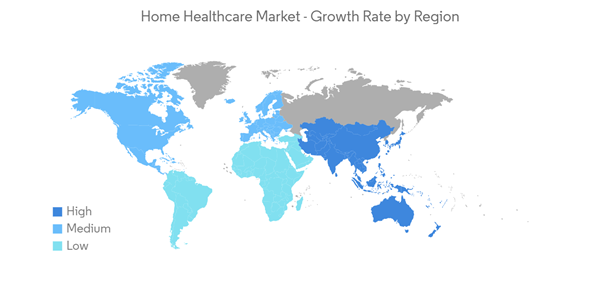The global home healthcare market is valued at USD 309.07 billion in 2024 and is expected to reach USD 500.39 billion by 2029 registering a CAGR of 8.46% over the forecast period.
The COVID-19 pandemic significantly impacted the home healthcare market. Home health hub technology made it possible for patients to stay safe in their homes during the pandemic while putting less strain on hospitals, emergency rooms, and front-line healthcare workers, which positively affected the market.ly affected the market. For instance, according to a research study published in the Lancet Regional Health in August 2021, home-based care has been in high demand ever since the COVID-19 pandemic began to relieve hospital overcrowding and enable patients with chronic illnesses or non-severe COVID-19 to receive treatment and monitoring at home. Thus, the pandemic positively impacted the home healthcare market and is expected to continue the upward trend over the forecast period.
The major drivers for the home healthcare market include rising disposable income, increasing surgical procedures, and rapid technological advancements in home healthcare. For instance, according to the PETERSON-KFF Health System Tracker data published in February 2022, healthcare spending in the United States increased by 9.7% to reach USD 4.1 trillion in 2020, an increase of around 4.3% compared to the previous year. The acceleration was due to a 36.0% increase in federal expenditures for health care that occurred largely in response to the COVID-19 pandemic. The same source also stated that the private business share of health spending accounted for 16.7% of total healthcare spending, state and local governments accounted for 14.3%, and other private revenues accounted for 6.5%. Thus, such an increasing disposable income is expected to propel the demand for home healthcare, which may surge the market growth.
The increasing number of surgical procedures across the globe is also expected to create demand for home healthcare services. For instance, according to the report published by the Department of Health & Family Welfare and Ministry of Health & Family Welfare in 2021-2022, till September 2021, about 8.29 lakh people visited OPDs, and around 33,830 surgeries were performed in Safdarjung Hospital, India. The same source also reported that around 25,101 minor surgeries were performed, and around 9,327 major surgeries were performed in India for 2020-21. Furthermore, from April 2021 to September 2021, around 7,223 minor surgeries and 17,004 surgeries were performed in India. Patients undergoing surgery require rigorous post-surgical care and constant health monitoring; thus, most people opt for home healthcare services. Thus, increasing cases of surgeries is expected to propel the market growth.
Furthermore, technological advances in the home healthcare space and increasing home healthcare services are also expected to boost market growth. In March 2022, Biofourmis announced that it had been selected by Blessing Health System in Quincy, Illinois, as a technology solutions partner for its newest program that delivers acute hospital care in patient's homes. Similarly, in December 2022, Tomorrow Health, a health tech company, launched a clinical rules engine that automates orders of durable medical equipment as a part of homecare. Thus, owing to such factors, the market is expected to grow considerably over the forecast period.
However, a lack of awareness among developing and underdeveloped countries will likely restrain market growth over the forecast period.
In addition, rising patient awareness levels towards screening process and technological advancements, integration of microfluidics, Internet-of-Things (IoT), sensors, smartphones, and wearables bring point-of-care testing to the patients and represent a strong opportunity for providing sensitive, low-cost, rapid, and connected diagnostics. For instance, in June 2021, Ro, the at-home diagnostics company Kit, was acquired by healthcare technology. The acquisition builds on the company's existing strengths, including nationwide telehealth, pharmacy, lab processing, and in-home testing and care services. It expands the diagnostics capabilities and lab infrastructure of Ro's vertically integrated primary care platform. With the help of Kit's at-home, self-administered testing solutions, Ro can support chronic and preventive care virtually and in patients' homes while facilitating patient-centric primary care experiences for a wider range of conditions. This resulted in high demand for this diagnostic equipment, driving the segment growth over the forecast period.
Key product launches, high concentration of market players or manufacturer's presence, partnerships among major players, and increasing cases of diseases in the United States are some of the factors driving the growth of the home healthcare market in the country. For instance, In February 2022, CVS Pharmacy launched six home healthcare products as an extension of the company's CVS Health product line. The new products include convertible shower chairs, easy-fold travel walkers, and canes with comfort grips. Similarly, in September 2022, Innovative Health Diagnostics launched Diagnostics as a Service (DaaS) platform, allowing brands to provide their patients access to at-home healthcare anytime and anywhere. Thus, owing to product launches, the market is expected to grow in the United States over the forecast period.
This product will be delivered within 2 business days.
The COVID-19 pandemic significantly impacted the home healthcare market. Home health hub technology made it possible for patients to stay safe in their homes during the pandemic while putting less strain on hospitals, emergency rooms, and front-line healthcare workers, which positively affected the market.ly affected the market. For instance, according to a research study published in the Lancet Regional Health in August 2021, home-based care has been in high demand ever since the COVID-19 pandemic began to relieve hospital overcrowding and enable patients with chronic illnesses or non-severe COVID-19 to receive treatment and monitoring at home. Thus, the pandemic positively impacted the home healthcare market and is expected to continue the upward trend over the forecast period.
The major drivers for the home healthcare market include rising disposable income, increasing surgical procedures, and rapid technological advancements in home healthcare. For instance, according to the PETERSON-KFF Health System Tracker data published in February 2022, healthcare spending in the United States increased by 9.7% to reach USD 4.1 trillion in 2020, an increase of around 4.3% compared to the previous year. The acceleration was due to a 36.0% increase in federal expenditures for health care that occurred largely in response to the COVID-19 pandemic. The same source also stated that the private business share of health spending accounted for 16.7% of total healthcare spending, state and local governments accounted for 14.3%, and other private revenues accounted for 6.5%. Thus, such an increasing disposable income is expected to propel the demand for home healthcare, which may surge the market growth.
The increasing number of surgical procedures across the globe is also expected to create demand for home healthcare services. For instance, according to the report published by the Department of Health & Family Welfare and Ministry of Health & Family Welfare in 2021-2022, till September 2021, about 8.29 lakh people visited OPDs, and around 33,830 surgeries were performed in Safdarjung Hospital, India. The same source also reported that around 25,101 minor surgeries were performed, and around 9,327 major surgeries were performed in India for 2020-21. Furthermore, from April 2021 to September 2021, around 7,223 minor surgeries and 17,004 surgeries were performed in India. Patients undergoing surgery require rigorous post-surgical care and constant health monitoring; thus, most people opt for home healthcare services. Thus, increasing cases of surgeries is expected to propel the market growth.
Furthermore, technological advances in the home healthcare space and increasing home healthcare services are also expected to boost market growth. In March 2022, Biofourmis announced that it had been selected by Blessing Health System in Quincy, Illinois, as a technology solutions partner for its newest program that delivers acute hospital care in patient's homes. Similarly, in December 2022, Tomorrow Health, a health tech company, launched a clinical rules engine that automates orders of durable medical equipment as a part of homecare. Thus, owing to such factors, the market is expected to grow considerably over the forecast period.
However, a lack of awareness among developing and underdeveloped countries will likely restrain market growth over the forecast period.
Home Healthcare Market Trends
Diagnostic Equipment Segment is Expected to Hold the Largest Market Share Over the Forecast Period
The diagnostic segment is expected to account for the most significant revenue over the forecast period due to a rise in chronic disorders, such as infectious diseases, diabetes, arthritis, cardiopulmonary, and cardiovascular conditions, which require continuous monitoring for efficient treatment. The rise in technological advancements in recent years led to the launch of new products for self-monitoring, like multi-parameter diagnostic monitors, home pregnancy, and fertility kits. For instance, according to the survey conducted by the WHO for the period from 24 January 2022 to 06 February 2022, approximately 12,368 people tested positive for influenza viruses. Of these, 8,423 (68.1%) people were infected with influenza A and 3,945 (31.9%) with influenza B. Furthermore, 171 (6.4%) were influenza A(H1N1), and 2,483 (93.6%) were influenza A (H3N2). Thus, increasing cases of infectious diseases are expected to propel the segment's growth.In addition, rising patient awareness levels towards screening process and technological advancements, integration of microfluidics, Internet-of-Things (IoT), sensors, smartphones, and wearables bring point-of-care testing to the patients and represent a strong opportunity for providing sensitive, low-cost, rapid, and connected diagnostics. For instance, in June 2021, Ro, the at-home diagnostics company Kit, was acquired by healthcare technology. The acquisition builds on the company's existing strengths, including nationwide telehealth, pharmacy, lab processing, and in-home testing and care services. It expands the diagnostics capabilities and lab infrastructure of Ro's vertically integrated primary care platform. With the help of Kit's at-home, self-administered testing solutions, Ro can support chronic and preventive care virtually and in patients' homes while facilitating patient-centric primary care experiences for a wider range of conditions. This resulted in high demand for this diagnostic equipment, driving the segment growth over the forecast period.
North America is Expected to Witness Considerable Growth Over the Forecast Period
Factors such as the high adoption of sophisticated technology, chronic and lifestyle diseases, rising healthcare spending, physician shortages, and increasing demand for better healthcare services all contribute to the market growth in the North American region. For instance, as per the Canadian Cancer Society Report published in 2021, over 229,200 new cancer cases were reported in Canada in 2021, and the five-year cancer survival rate in the country reached 64%. In addition, increasing cases of chronic diseases in the region are also expected to propel market growth. For instance, according to the International Diabetes Federation's Diabetes Atlas, Tenth Edition, in 2021, around 32.2 million people in the United States had diabetes, projected to grow to 36.3 million by 2045. Thus, such factors are expected to propel the market growth in the North American region.Key product launches, high concentration of market players or manufacturer's presence, partnerships among major players, and increasing cases of diseases in the United States are some of the factors driving the growth of the home healthcare market in the country. For instance, In February 2022, CVS Pharmacy launched six home healthcare products as an extension of the company's CVS Health product line. The new products include convertible shower chairs, easy-fold travel walkers, and canes with comfort grips. Similarly, in September 2022, Innovative Health Diagnostics launched Diagnostics as a Service (DaaS) platform, allowing brands to provide their patients access to at-home healthcare anytime and anywhere. Thus, owing to product launches, the market is expected to grow in the United States over the forecast period.
Home Healthcare Industry Overview
The home healthcare market is moderately competitive and consists of several major players. Some companies are expanding their market position by adopting various strategies, such as mergers and acquisitions and research collaborations with other companies to launch innovative products and consolidate their market positions worldwide. Some companies currently dominating the market are Amwell, ResMed Inc., Fresenius SE & Co KGaA, F. Hoffmann-La Roche AG, and Apple Inc., among others.Additional Benefits:
- The market estimate (ME) sheet in Excel format
- 3 months of analyst support
This product will be delivered within 2 business days.
Table of Contents
1 INTRODUCTION
4 MARKET DYNAMICS
5 MARKET SEGMENTATION (Market Size by Value - USD)
6 COMPETITIVE LANDSCAPE
Methodology

LOADING...










